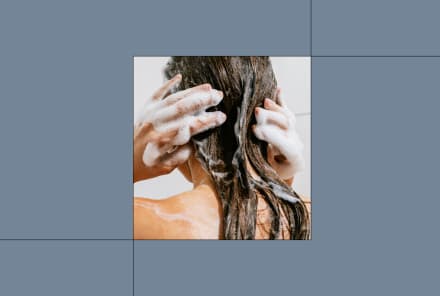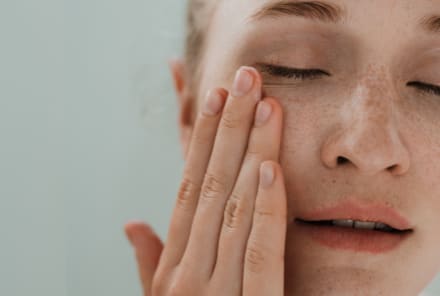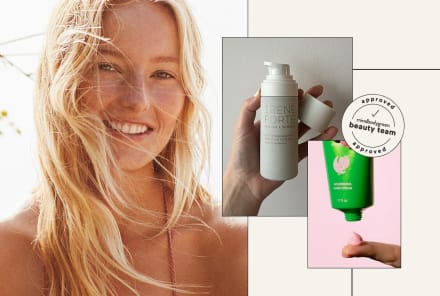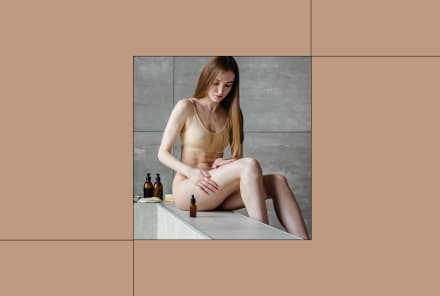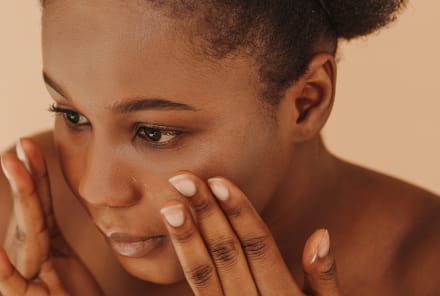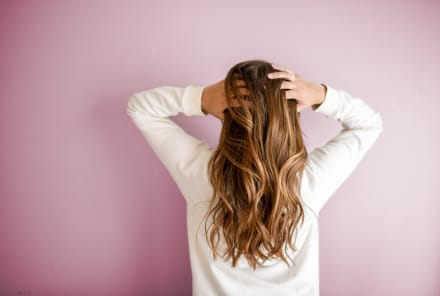Advertisement
Silicones In Shampoo, Conditioner & Hair Care: Bad For Hair Health Or Overreaction?

One area of hair care drums up a lot of debate: silicones. They're found in, well, a lot of products. Unless a product is 100% natural oils or specifically claims it is "silicone-free," it likely has some variation of silicones. (And even then, it might include silicone derivatives.) So why does all the controversy start bubbling up the second you drop the "S" word around hair care and even skin care fanatics? The answer takes some explaining, so allow us.
What are silicones?
Silicones are a class of compounds that adds silky texture to hair and skin care products. They are derived from the natural element silica and go through several chemical reactions to become the silicones that end up in our products. They are used to create an appealing texture, provide slip when applying, and give the appearance of shine on the hair and skin. Silicones are occlusive in nature: "Their main function is to create a physical barrier coating on the skin and hair that is resistant to water and air," says board-certified dermatologist Zenovia Gabriel, M.D., FAAD.
There are several types of silicones, and each with a different profile and characteristics. "Silicones have many names, but a good rule of thumb is to look for something ending in -cone on your product's ingredient list. Most silicones (but not all) end in -cone," says Ron McLaughlin, vice president of research and development at Living Proof, a clean-leaning hair care brand that helped pioneer and usher in the wave of silicone-free products.
Here are a few common names: dimethicone, amodimethicone, cyclomethicone, methicone, trimethicone, nylon, trimethylsilylamodimethicone, dimethiconol, bis-PEG-18 methyl ether dimethyl silane.
Why are they used in hair care?
The short answer: They are cheap, effective, and make hair appear shiny and frizz-free. Formulating hair care products with oils and nutrients to achieve the same slip and sheen is time- and cost-consuming. Not to mention, they do provide pretty appealing aesthetic benefits in the short term: Shiny, frizz-free, softer hair is a hard thing to turn away.
Are silicones bad for hair health?
The answer is, like many areas of beauty, it's complicated. But there are some key points we can boil down to make it a little more digestible.
They aren't dangerous to human health.
Often, clean and natural beauty enthusiasts will avoid ingredients because they have been deemed dangerous—or at least questionable—to human health. These are things like phthalates, parabens, formaldehyde resin, and other things you see pop up on many "no" lists. Silicones do not fall under that same level of scrutiny as they are not known carcinogens or endocrine disrupters. "They are also an incredibly safe ingredient to use in skin care and hair care," says Rachel Nazarian, M.D., of Schweiger Dermatology Group.
There are valid reasons to choose to stop using silicones, many outlined here, but much of the confusion around silicones arises when they are conflated with "dangerous toxins and chemicals"—silicones just don't reach that bar.
Silicones only provide an aesthetic benefit; they do nothing for overall hair health.
As noted above, silicones make hair shiny, soft, frizz-free, and manageable. But it does this by making a superficial coating around the strand, not by providing the hair nutrients or moisture.
"They are the extra filler that help a product feel more luxurious," says Gabriel. Compare it to using a natural hair oil that uses ingredients like vitamin E, jojoba, or argan: These also make your hair shiny, tame frizz, and improve manageability, but they do so by feeding the hair antioxidants, fatty acids, amino acids, minerals, and the like. So you are getting the aesthetic benefit while also improving the quality of your hair.
They seal in water but can also block out moisture and nutrients over time.
A quick check-in about occlusive materials: Nothing gets out, but nothing gets in. Silicones do prevent moisture loss, as they seal in water in the hair strand via that occlusive coating. However, the problem arises when they don't unseal from your hair in the shower.
Silicones are hydrophobic,1 meaning they repel water. They do this by nature, and the reason they are theoretically great at reducing frizz (frizz is caused by humidity lifting up the hair's cuticle2, resulting in a frayed, puffy texture). So when you wash it, they cling to hair and don't easily rinse off as they are repelling the water instead of dissolving in it.
So if you use a leave-in conditioner with silicones then go to wash it with a shampoo that contains silicones, and then condition with silicones, that routine is likely causing quite a bit of silicone layering and buildup on the scalp and strand. So even if these individual products contain good-for-hair ingredients, those nutrients may not be able to penetrate the shaft because of the occlusive silicone coating.
Silicone buildup triggers a viscous wash cycle.
"The obvious drawback of all this is that you end up with hair that gets weighed down or greasy, so you are more likely to shampoo and style more often. This perpetuates what we call the cycle of damage. The more you wash and style, the more damaged your hair is, so the more you will feel like you need to reach for a silicone to get that soft feeling again. It's a vicious cycle," says McLaughlin. If you need guidance on how often you should actually be washing your hair, read our guide to shampooing.
Alarmingly, many silicones are not biodegradable.
As we've already discussed: Silicones do not break down easily in water. And we must remember, even if we are able to wash the molecule off our strands, it doesn't just disappear. It goes down the drain and begins to bioaccumulate in our water supply3.
"One of the main reasons silicones are not used in the natural space is because they are not eco-friendly," says Gabriel. "If a person uses products that contain silicones and they then go to wash their hands after application, the silicones are rinsed down into the drain. This could then contribute to pollution in our oceans as they can take hundreds of years to break down."
Now, the beauty industry causes a lot of waste—that's no secret—and many eco-issues certainly trump the potential bioaccumulation of silicones. (Plastic waste and water consumption, for example!) But it's certainly part of the bigger picture.
If you use sulfate-free shampoos, you should skip silicones.
Those who avoid silicones avoid them largely in part because they avoid another type of ingredient: sulfates. Sulfates, as you may know, are a strong, foaming surfactant used in many shampoos and washes. Sulfate-free shampoos, which have come a long way in recent years, are at their core a more gentle wash. This is a good thing, as it doesn't disrupt our microbiome, harm our skin barrier function, or strip away our natural oils. However, it also means it's not necessarily as effective at lifting up the buildup caused by silicones.
There are water-soluble silicones that are generally safe.
Remember how we previously noted that not all silicones are bad? Well, that's because researchers were able to develop water-soluble silicones that are generally fine in hair care, as they are easier to remove, aren't as sticky of an occlusive, and don't bioaccumulate. Look for dimethicone copolyol or any dimethicone with a PEG prefix, like PEG-8 (or higher) dimethicone.
What about silicones for skin care?
For whatever reason, silicones in skin care don't trigger as much controversy. Silicones are added to skin care products to achieve an appealing texture and slip. However, they come with many of the same characteristics as above: They don't necessarily provide overall health benefits, but they are generally deemed safe.
That being said, here are skin-specific recommendations:
- Silicones may be comedogenic, so be wary if you have acne-prone skin: "I would not recommend products with silicones for acne-prone skin due to their occlusive nature—meaning they can easily block pores and cause acne to flare," says Gabriel.
- Silicones may cause irritation if you are prone to heat rashes: "Since it acts as a type of barrier, it can trap heat more readily on the skin," says Nazarian. "If you have certain skin conditions that make you sensitive to warm temperatures or prone to heat rashes or irritation from sweat, you may want to use a product that is a little bit more 'breathable' But for the vast majority of people, this ingredient is fine."
- Silicones are used by dermatologists for wound healing: "Silicones are a highly researched ingredient for scar remodeling4, for help in both new and old scars, and for help in keloid scarring. Silicone is the only ingredient that has significant research to support its use," says Morgan Rabach, board-certified dermatologist and co-founder of LM Medical NYC. "For the research in scar use and my own personal experience using it with patients, I am a big fan."
The take-away.
While silicones are safe for human use, they don't necessarily add benefit to your overall health. They exist to provide aesthetic improvements in the short run but cause buildup and overwashing in the long term due to their occlusive nature. They also may contribute to bioaccumulation in our water supply, which may be enough of a reason to nix overuse. All in all, there are valid reasons some may choose to avoid them in hair care—the most important thing is that you are informed about what they do and don't do.
Watch Next
Enjoy some of our favorite clips from classes
Enjoy some of our favorite clips from classes
What Is Meditation?
Mindfulness/Spirituality | Light Watkins
Box Breathing
Mindfulness/Spirituality | Gwen Dittmar
What Breathwork Can Address
Mindfulness/Spirituality | Gwen Dittmar
The 8 Limbs of Yoga - What is Asana?
Yoga | Caley Alyssa
Two Standing Postures to Open Up Tight Hips
Yoga | Caley Alyssa
How Plants Can Optimize Athletic Performance
Nutrition | Rich Roll
What to Eat Before a Workout
Nutrition | Rich Roll
How Ayurveda Helps Us Navigate Modern Life
Nutrition | Sahara Rose
Messages About Love & Relationships
Love & Relationships | Esther Perel
Love Languages
Love & Relationships | Esther Perel

